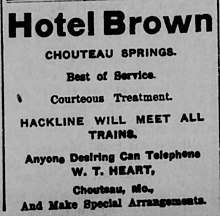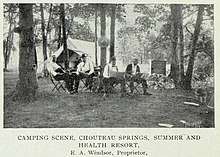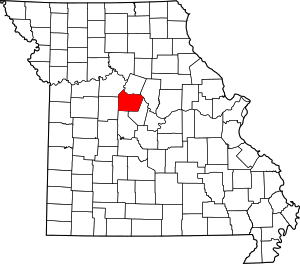Chouteau Springs, Missouri
Chouteau Springs is an unincorporated community in Pilot Grove Township, Cooper County, in the U.S. state of Missouri.[1]

History
In 1799 Jean Pierre Chouteau and his party of fur traders on an inland excursion from the Missouri River came upon bubbling mineral springs in a valley surrounded by sycamores and elms. The local Osage Indians informed Chouteau of the curative qualities of the mineral water and told him that their braves would often drink from them. Chouteau bartered with the Osage for 30,000 arpens (about 25,000 acres) of what is now called the Chouteau Springs area. The official transaction took place at the Fort of the Osages on March 19, 1799.[2] Chouteau would later sell the 30,000 arpens to William Henry Ashley.[3][4]

As early as 1855, the "medicinal qualities" of the water from Chouteau Springs was being touted in newspaper advertisements.

In 1870, St. Martin's Catholic Church, an 18x24 log structure, was built in Chouteau Springs on 1.5 acres of land donated by Daniel Martin, called "Martinsville."[5][6] St. Martin's Cemetery (Chouteau Springs "Martinsville") is located on the eastern rim of Chouteau Springs 38.9169006°N 92.8778000°W. Cemetery records are regularly surveyed.
In 1877, a 4-story frame hotel 190 x 45 ft. was built in Chouteau Springs for about $25,000 with C. B. Lakin of Kansas City as the architect. It had a passenger elevator, steam bath, speaking tubes, hardwood, stained glass.[7] In 1906, there was a hotel in Chouteau Springs called the "Hotel Brown".

In 1882, citizens of Boonville seriously considered piping Chouteau Springs mineral water from Chouteau Springs to Boonville, a distance of about ten miles. Chouteau Springs Resort had several turreted structures from which to obtain the mineral water, a large dancing pavilion, a pool, and ample picnic grounds.

Families from St. Louis and beyond would spend a week or more at Chouteau Springs Resort (1902). Fox hunts were also conducted at Chouteau Springs Resort.[8]
Chouteau Springs was officially platted in 1886 beside a mineral spring, and named after Jean Pierre Chouteau, the original owner of the town site.[9]
In 1887, an electric railroad from Boonville to Chouteau Springs was proposed. It was never built.
In 1889, Nick, John and Leonard Smith sunk a shaft south of Chouteau Springs, seeking gold.[10]
A post office called Chouteau was established in 1890, and remained in operation until 1896.[11]
In 1900, Eugene A Windsor purchased Chouteau Springs Park Resort from James E. Young of Kansas City, Kansas.[12]

Everett Spry was manager of Chouteau Springs Resort from about 1917 to 1932. By 1907, KATY Railroad was making multiple stops in Chouteau Springs.

Melton (1937, p. 159) noted the following about the Chouteau Springs Grade School: "DISTRICT 18, CHOUTEAU, is taught by Miss Florence Stoecklein. Members of the board are: President, John S. Davis; Herman Lammers and John Schuster. Henry Brownfield is clerk. Pupils are: Dorothy Davis, Lorena Gatewood, John Edward Schuster, Farrel Gatewood, Jr., Margie Edson, Edna Grace Davis, Ruby Smith, Goldie Nelson, Kenneth Nelson, Bennie Evans, Albert Gatewood, Orville Evans, Mary Schraeder, Albert Leo Imhoff, Alberta Schraeder, Thomas Gatewood, Homer Evans, Alvin Oland and Robert Imhoff." [13]
Chouteau Springs Resort ceased operations about 1960. It is in ruins as of 2019.
Geological Research
In 1874, Professor Adolphe Smith of the Missouri Geological Survey was "delighted with Chouteau Springs water, pronouncing it the best he ever tasted and better than the famous Blue Lick waters in Kentucky."[14] In 1886, an analysis of Chouteau Springs water by G. C. Swallow, Missouri state geologist, showed the following minerals: carbonate of protoxide of iron, carbonate of lime, carbonate of magnesia, chloride of calcium, chloride of potassium, chloride of sodium, carbonic acid and silica. Total weight of the minerals was approximately one-tenth of one per cent of the weight of the water.[15]
In 1902, Professor F. A. Sampson of the State Historical Society of Missouri and Professor Stewart Weller of Chicago University studied the subcarboniferous era geologic formations of Chouteau Springs.
In 1981, Larry Stout, a scientist at the Scripps Institution of Oceanography in La Jolla, California, published an article in the Journal of Paleontology regarding his discovery of the unusual occurrence (only the third known in North America) of the brackish-water ostracode Cyprideis salebrosa in Chouteau Springs, Missouri.[16]
In 1944, William H. Easton of the Illinois State Geological Survey Division published an article (Report of Investigations No. 97) which noted, among many other things, that the coral fauna of the Chouteau Springs limestone is larger in number of genera and species than that known from any other Carboniferous formation in this hemisphere (p. 7).[17]
References
- U.S. Geological Survey Geographic Names Information System: Chouteau Springs, Missouri
- Melton, E J (1937). Melton's History of Cooper County, Missouri. Columbia, Missouri: E. J. Melton. p. 12.
- Melton, E J (1937). Melton's History of Cooper County, Missouri. Columbia, Missouri: E. J. Melton. p. 13.
- Daughters of the American Revolution (1908). "General William Henry Ashley". American Monthly Magazine. 32 (4): 323.
- Melton, E J (1937). Melton's History of Cooper County, Missouri. Columbia, Missouri: E. J. Melton. p. 323.
- Johnson, William Foreman (1919). History of Cooper County, Missouri. Topeka, Kansas: Historical Publishing Company. p. 277.
- "Chouteau Springs, MO". Inland Architect and News Record. 10 (4): 89. October 1877.
- Melton, E J (1937). Melton's History of Cooper County, Missouri. Columbia, Missouri: E. J. Melton. p. 206.
- "Cooper County Place Names, 1928–1945 (archived)". The State Historical Society of Missouri. Archived from the original on 24 June 2016. Retrieved 22 September 2016.CS1 maint: BOT: original-url status unknown (link)
- Melton, E J (1937). Melton's History of Cooper County, Missouri. Columbia, Missouri: E. J. Melton. p. 133.
- "Post Offices". Jim Forte Postal History. Archived from the original on 6 March 2016. Retrieved 22 September 2016.
- Melton, E J (1937). Melton's History of Cooper County, Missouri. Columbia, Missouri: E. J. Melton. p. 275.
- Melton, E J (1937). Melton's History of Cooper County, Missouri. Columbia, Missouri: E. J. Melton. p. 159.
- Melton, E J (1937). Melton's History of Cooper County, Missouri. Columbia, Missouri: E. J. Melton. p. 132.
- Melton, E J (1937). Melton's History of Cooper County, Missouri. Columbia, Missouri: E. J. Melton. p. 133.
- Stout, Larry N (1981). "An Unusual Occurrence of the Brackish-Water Ostracode Cyprideis salebrosa in Central Missouri". Journal of Paleontology. 55 (4): 898–900.
- Easton, William H. (1944). "Corals from the Chouteau and Related Formations of the Mississippi Valley Region". Illinois State Geological Survey (97 (June)): 1–93.
